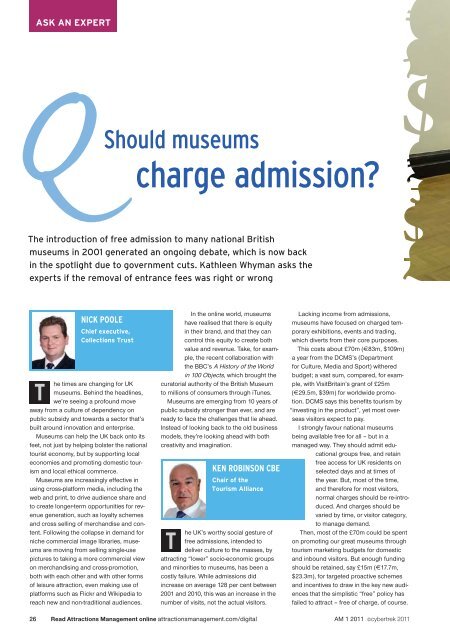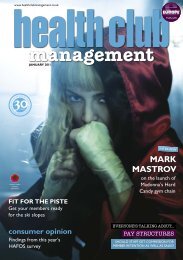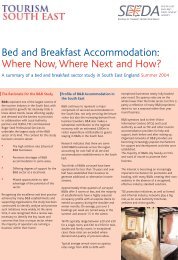Attractions Management Issue 1 2011 - TourismInsights
Attractions Management Issue 1 2011 - TourismInsights
Attractions Management Issue 1 2011 - TourismInsights
Create successful ePaper yourself
Turn your PDF publications into a flip-book with our unique Google optimized e-Paper software.
Q<br />
<br />
<br />
<br />
<br />
<br />
<br />
<br />
he times are changing for UK<br />
museums. Behind the headlines,<br />
we’re seeing a profound move<br />
away from a culture of dependency on<br />
public subsidy and towards a sector that’s<br />
built around innovation and enterprise.<br />
Museums can help the UK back onto its<br />
feet, not just by helping bolster the national<br />
tourist economy, but by supporting local<br />
economies and promoting domestic tourism<br />
and local ethical commerce.<br />
Museums are increasingly effective in<br />
using cross-platform media, including the<br />
web and print, to drive audience share and<br />
to create longer-term opportunities for revenue<br />
generation, such as loyalty schemes<br />
and cross selling of merchandise and content.<br />
Following the collapse in demand for<br />
niche commercial image libraries, museums<br />
are moving from selling single-use<br />
pictures to taking a more commercial view<br />
on merchandising and cross-promotion,<br />
both with each other and with other forms<br />
of leisure attraction, even making use of<br />
platforms such as Flickr and Wikipedia to<br />
reach new and non-traditional audiences.<br />
In the online world, museums<br />
have realised that there is equity<br />
in their brand, and that they can<br />
control this equity to create both<br />
value and revenue. Take, for example,<br />
the recent collaboration with<br />
the BBC’s A History of the World<br />
in 100 Objects, which brought the<br />
curatorial authority of the British Museum<br />
to millions of consumers through iTunes.<br />
Museums are emerging from 10 years of<br />
public subsidy stronger than ever, and are<br />
ready to face the challenges that lie ahead.<br />
Instead of looking back to the old business<br />
models, they’re looking ahead with both<br />
creativity and imagination.<br />
<br />
<br />
<br />
<br />
he UK’s worthy social gesture of<br />
free admissions, intended to<br />
deliver culture to the masses, by<br />
attracting “lower” socio-economic groups<br />
and minorities to museums, has been a<br />
costly failure. While admissions did<br />
increase on average 128 per cent between<br />
2001 and 2010, this was an increase in the<br />
number of visits, not the actual visitors.<br />
Lacking income from admissions,<br />
museums have focused on charged temporary<br />
exhibitions, events and trading,<br />
which diverts from their core purposes.<br />
This costs about £70m (83m, $109m)<br />
a year from the DCMS’s (Department<br />
for Culture, Media and Sport) withered<br />
budget; a vast sum, compared, for example,<br />
with VisitBritain’s grant of £25m<br />
(29.5m, $39m) for worldwide promotion.<br />
DCMS says this benefits tourism by<br />
“investing in the product”, yet most overseas<br />
visitors expect to pay.<br />
I strongly favour national museums<br />
being available free for all – but in a<br />
managed way. They should admit educational<br />
groups free, and retain<br />
free access for UK residents on<br />
selected days and at times of<br />
the year. But, most of the time,<br />
and therefore for most visitors,<br />
normal charges should be re-introduced.<br />
And charges should be<br />
varied by time, or visitor category,<br />
to manage demand.<br />
Then, most of the £70m could be spent<br />
on promoting our great museums through<br />
tourism marketing budgets for domestic<br />
and inbound visitors. But enough funding<br />
should be retained, say £15m (17.7m,<br />
$23.3m), for targeted proactive schemes<br />
and incentives to draw in the key new audiences<br />
that the simplistic “free” policy has<br />
failed to attract – free of charge, of course.<br />
26<br />
Read <strong>Attractions</strong> <strong>Management</strong> online attractionsmanagement.com/digital<br />
AM 1 <strong>2011</strong> ©cybertrek <strong>2011</strong>
















